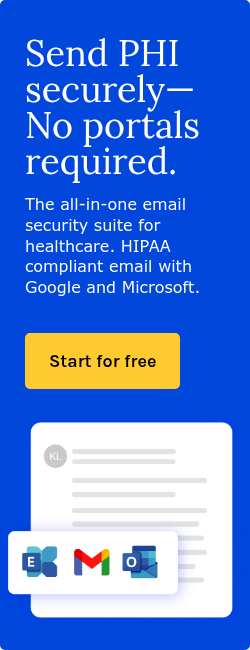6 min read
Using HIPAA compliant emails to increase spina bifida awareness
Caitlin Anthoney June 02, 2025

Spina bifida is “the most common permanently disabling birth defect in the United States,” with around 1,500 babies born each year with this neural tube defect, according to the Spina Bifida Research Network (SBRN).
Folic acid fortification has reduced incidence over the past few decades, however, the condition continues to affect thousands of families medically, emotionally, and financially.
While this issue continues to challenge many, proper communication and education can help ease the burden of finding answers and support.
What is spina bifida?
Spina bifida is a neural tube defect that occurs when the spine and spinal cord don’t form properly during early fetal development. According to SBRN, “it typically happens within the first 28 days of pregnancy,” often before a woman even knows she’s pregnant.
There are three types:
- Occulta (hidden and often undetected),
- Meningocele (a visible sac containing fluid but no spinal nerves), and
- Myelomeningocele is the most severe form, in which the spinal cord and nerves are exposed through an opening in the spine.
Complications include paralysis, bowel and bladder dysfunction, orthopedic abnormalities, and often hydrocephalus, which requires surgical intervention. “40% of shunts for hydrocephalus fail or become infected and need to be changed within 1 year; 60% within 5 years; 80–85% within 10 years,” the SBRN reports.
The complexity of these cases often requires coordinated care between neurologists, pediatricians, surgeons, therapists, educators, and parents.
Additionally, the average lifetime cost of care for a child born with spina bifida is around $800,000 in the U.S., with hospitalization costs exceeding $600 million annually. Given these realities, healthcare providers must increase spina bifida awareness and prevention.
Prevention through folic acid awareness
Research indicates that environmental and genetic factors contribute to spina bifida, but a major preventative measure is sufficient folic acid intake. According to a 2024 Narrative Review on Spina Bifida Prevention and Folic Acid Supplements for Childbearing Age Women, “Women who, along with a healthy diet and lifestyle, take 400 mcg of folic acid daily before pregnancy and during the first trimester, reduce the risk of having a baby born with spina bifida by up to 70%.”
Spreading spina bifida awareness
Healthcare providers must use HIPAA compliant email solutions, like Paubox, to communicate sensitive health information, including information on spina bifida. These solutions use advanced encryption to safeguard individuals’ protected health information (PHI) during transmission and rest.
Consequently, providers, hospitals, and advocacy organizations can share educational content, prevention strategies, and support resources about spina bifida.
More specifically, healthcare facilities can send secure emails to women of childbearing age, reminding them to take folic acid supplements and explaining its benefits in reducing neural tube defects like spina bifida.
Clinics can also provide educational newsletters directly to patients or community members. These emails should contain accessible language and visuals that clarify the early prevention of spina bifida.
For example, a community health center could launch a campaign before and during National Birth Defects Prevention Month using HIPAA compliant emails. These secure emails could feature facts about spina bifida, reminders about folic acid intake, and local resources for prenatal care.
Educating women and communities securely
“Nearly three-fourths of a population being educated on the necessity of folic acid supplementation is promising, but it is also important to investigate specific populations to identify groups at the highest risk of suboptimal education levels about this topic,” the review explains.
Educating the public about the link between folic acid deficiency and spina bifida can happen in many settings, including healthcare facilities, physician offices, schools, and online. Using HIPAA compliant emails as part of this approach lets healthcare providers maintain confidentiality while reaching women wherever they are.
Physician offices can send appointment reminders that include secure links to downloadable pamphlets on folic acid and spina bifida prevention. Schools with adolescent health programs can email parents and guardians educational materials in multiple languages to help bridge cultural and linguistic gaps.
Online campaigns can safely distribute webinars, fact sheets, and videos through secure email invitations. These initiatives can encourage women to engage with healthcare providers, ask questions, and receive personalized advice. For instance, a school program could send encrypted emails inviting families to virtual workshops on prenatal health, making participation more convenient.
Supporting families with ongoing care information
According to the narrative review, “the dynamics of the child’s family life will also be affected depending on the severity of the illness and developmental disabilities that ensue.” Families may face emotional, logistical, and financial pressures as they adapt to daily routines structured around medical care, therapy appointments, and specialized equipment needs.
Consequently, parents are full-time advocates and care coordinators, managing multiple specialists and making complex decisions about surgery, rehabilitation, and school accommodations. This could strain relationships, impact employment, and challenge a family’s mental health.
HIPAA compliant emails can help ease some of these challenges, streamlining communication and reducing the number of in-person visits or follow-up phone calls required.
Providers can securely send updates on therapy progress, appointment changes, or lab results directly to parents’ inboxes. These emails would prevent miscommunication and empower caregivers to stay organized, make informed decisions, and focus on their child’s needs.
For extended family members and guardians, secure emails allow broader participation in the child’s care plan, creating more connected, coordinated care for families navigating life with spina bifida.
These emails can also provide information on adaptive equipment, mobility aids, and community resources to improve quality of life. Including updates about support groups, empowerment retreats, and advocacy events fosters a sense of community and shared experience for families.
For example, the Spina Bifida Research Network hosts an annual peer-led empowerment retreat, giving adults with disabilities a safe space to discuss challenges and successes. According to their website, the retreat “is a peer-led, interactive event for disabled adults 21+ that promotes interdependence, socialization and self-empowerment. Disabled speakers lead engaging discussions on healthcare, relationships, advocacy, fitness, disability justice, and more, as well as fun, community-building activities.”
Providers can send secure invitations and event information via HIPAA compliant email, ensuring privacy and encouraging participation either in-person or online.
For example, a pediatric neurology department can send secure follow-up emails to parents of children diagnosed with spina bifida, giving them personalized care instructions, therapy reminders, and motivational messages to encourage adherence to treatment plans.
Community organizations can also use HIPAA compliant emails to invite families to virtual workshops on managing aspects of living with spina bifida like bladder and bowel care. These invitations should include encrypted registration links and confidential contact information for follow-up.
Promoting research and collaboration
Spina bifida research continues to improve, from prenatal surgical techniques to new therapies for hydrocephalus management. Healthcare providers can use HIPAA compliant emails to share the latest research findings securely with other medical professionals for continuous improvement in care standards.
These secure emails allow hospitals and research centers to collaborate and update colleagues on emerging treatments, clinical trial opportunities, and patient outcomes without risking PHI breaches.
For instance, providers may receive encrypted newsletters detailing advances in fetal surgery that can close spinal openings in utero, improving mobility prospects for affected children.
Ultimately, this information sharing would benefit healthcare professionals and help educate patients about new options so they can make informed decisions.
Improving spina bifida outcomes through secure communication
Spina bifida creates lifelong challenges, but many individuals live full, productive lives with effective treatment and support, as evidenced by the Spina Bifida Research Network. Over 90% of babies born with spina bifida reach adulthood, thanks in part to early interventions, surgical advances, and ongoing care coordination.
As the Research Network states, “With effective treatment, equipment, and support, people with spina bifida live full and productive lives.”
HIPAA compliant emails facilitate these improvements through effective communication between patients, providers, and support networks while protecting privacy. Since healthcare data breaches are increasingly common, securing sensitive communication builds trust and encourages patients to engage more actively in their care.
As Lee Kim, senior principal of cybersecurity and privacy at HIMSS, notes, “There are no shortcuts… the fundamental thing that needs to be done is setting up a robust third-party risk management program.”
According to the 2024 HIMSS Healthcare Cybersecurity Survey, general email phishing (63%) remains the top initial point of compromise, followed by SMS phishing and targeted spear-phishing (34%).
Paubox’s encrypted email technology helps close these gaps with advanced encryption that prevents common threats like phishing websites, malicious ads, or business email compromise.
Ultimately, its advanced security supports providers in sending personalized health tips, educational materials, and care reminders, informing new mothers about folic acid, or coordinating multidisciplinary care for a child with spina bifida.
FAQs
What measures can providers take to ensure HIPAA compliance?
Providers can implement administrative, physical, and technical safeguards (like using Paubox), conduct regular risk assessments, and provide staff training to maintain HIPAA compliance.
Can my family access my health information?
Only if you give them permission. Under HIPAA, your healthcare provider can share your health information with a family member, friend, or caregiver only when you give verbal or written consent, or when you’re present during the discussion and don’t object. If you're unconscious or unable to make decisions, the provider may use their professional judgment to determine if sharing certain information is in your best interest.
Can I ask for my health records in a digital format?
Yes, you can request your medical records in the format you prefer, like electronic or paper copies. HIPAA requires providers to accommodate your request if they can do so without significant difficulty.
If your provider cannot produce the records in your preferred format, they must offer an accessible alternative. They are also required to respond to your request within 30 days and may only charge reasonable fees that cover the cost of copying, mailing, or preparing the records. If your provider refuses or delays without a valid reason, this may be a HIPAA violation.
Subscribe to Paubox Weekly
Every Friday we'll bring you the most important news from Paubox. Our aim is to make you smarter, faster.




